
7 Budget Friendly Ways To Remodel A Dream Bathroom And Not Break The Bank!
Limited budget? 7 Tips On How To Save Money On Your Bathroom Remodel!
DO YOU HAVE A LIMITED BUDGET BUT NEED A BATHROOM REMODEL OR REFRESH? YOU CAN STILL CREATE A DREAM BATHROOM DESIGN EVEN WITH A TIGHT POCKETBOOK!
7 KEY BUDGET FRIENDLY TIPS ON HOW TO SAVE MONEY ON YOUR BATHROOM REMODEL!
Have you lived with those outdated pink flowered tiles in your bathtub space for long enough? Have you had enough of your “1980’s” inspired laminate countertop or your short ivory coloured toilet? Then you need a design upgrade for your bathroom, but in today’s economy with the high cost of living; the budget is tight making your dream luxury bathroom seem out of reach. So, what can you do?
Bathrooms and kitchens are the main areas of the house that most homeowners would love to remodel and update. However, both projects have a tendency to be costly. So, when saving costs is the primary goal, bathroom remodels can overrun and get out of control. Unless you just won the lottery or you have struck it rich, you will most likely need to stay within a certain budget for your bathroom upgrade. We would all love to have a beautiful, luxurious, spa-like bathroom space, but the reality is there is only a certain amount of money available for this dream remodel endeavour. However, dreams can come true as there are ways you can still renovate your bathroom while implementing budget-friendly measures.
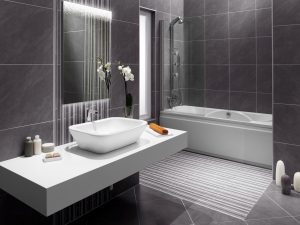
BUDGET-FRIENDLY BATHROOM REDESIGN FEATURING THE SIDLER GRADIENT COLLECTION
We are going to share with you the 7 key tips on how you can create a dream bathroom design while still saving money. These design tips ensure you can both update your bathroom design while adding quality value within your home and everyday bathroom needs without sacrificing your budget!
Let’s jump in and take a look at the key tips to create a budget-friendly ‘dream’ bathroom redesign!
HERE ARE 7 KEY TIPS ON HOW TO REMODEL YOUR BATHROOM SPACE WITHOUT BREAKING THE BANK!
PLAN AHEAD
Before you start taking out that old tile or unscrewing any knobs, create a plan and budget for your bathroom upgrade. Having a laid out written plan will help you stay on track as the project begins and progresses. Your plan and budget should include anything you would like to update, replace or add to the bathroom including material costs, and possible labour costs.
During any remodelling project, one of the costliest things you can do is change your plans halfway through. There are definitely times during the progress of a remodel changes are unavoidable such as, when you cut into a wall and discover a leak, but for the most part proper planning within the budget can be achieved. If a carefully laid out renovation plan is not in place, this not only can cause delays in the project or wasted time spent changing the fixtures and materials for different ones; it also requires you to pay contractors to redo work already started or completed. It’s much less costly to know in advance for example, that you don’t want the toilet to be the first thing guests see when they open the door vs realizing this is an issue after the fact when its already been installed.
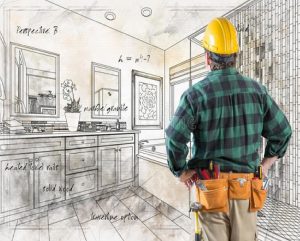
So, the first step in any bathroom remodel is planning. Before you buy anything or hire anyone, think about what you want from your new bathroom. Ask yourself what doesn’t work for you now in your current bathroom and devise how this can be fixed. Make a list of everything you want in your remodeled bathroom, and then divide the list into must-have and nice-to-have categories.
As well as planning the layout, spend time comparing options for visual elements such as tile, plumbing fixtures, and light fixtures. This ensures when you are ready to get started, you have a list of kitchen and bath stores where you can find what you want at the best price.
DO THE WORK YOURSELF
For any bathroom remodel, roughly half the cost is labour costs paying contractors including, carpenters, plumbers, electricians, drywallers and floor tilers. One of the most cost-effective ways to save money on a bathroom remodel is to do it yourself.
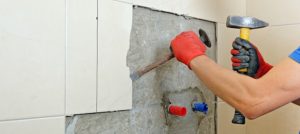
Homeowners with a little DIY experience can take on more ambitious DIY projects. The more you can handle certain aspects of your bathroom remodel, the more money you can save. A DIY can be a money-saver if you have the necessary DIY experience or skills so, you can instead invest the budget for a professional to do the more involved or difficult work.
Depending on your experience and skill level, you can tackle jobs such as:
- Demolition (pulling out old wallboard, flooring, and cabinetry).
- Painting walls, cabinets, or fixtures.
- Tiling the walls, floor, shower, or bath.
- Replacing the faucets, handles or showerhead.
- Installing light fixtures.
- Installing new plumbing fixtures.
Start with the things on this suggested list you are comfortable handling on your own and leave the rest to a professional contractor. Taking the DIY approach can significantly reduce your labour costs.

RETAIN CURRENT FOOTPRINT, WIRING AND PLUMBING
One of the best ways to save on a bathroom remodel is not to remodel at all. There is an interchangeable misuse of terms in regard to the definition of “bathroom remodelling” vs “bathroom renovation”.
However, these two terms are not the same thing. Remodelling involves making significant changes to a room’s footprint, size, shape, or structure. A renovation is a freshening up of the bathroom’s appearance in terms of tiles, wall color, flooring, lighting while still leaving its basic layout unaltered.

So, here are some suggestions on how to save money on refreshing your bathroom design:
- Retain the Bathroom Size and Layout – Enlarging or rearranging a bathroom often means moving electrical or plumbing pipes, which can be expensive. The toilet discharge and sewer pipe are particularly expensive to move. Changing the footprint adds time and labour costs to the project. It also usually involves getting building permits, which are a significant expense. The less costly bathroom ‘facelift’ is to do a renovation rather than a full remodel.
Therefore, only resize or alter the bathroom if it is necessary to accommodate your needs as moving objects that can’t be moved with ease is the single most expensive aspect of bathroom remodelling. If you want to alter the size or layout of your bathroom during a remodel, weigh the cost vs benefits of such an alteration in how it will impact you financially.
There are a number of ways to change the appearance of a bathroom without changing the footprint. You can change the fixtures, walls, flooring, lighting, and accessories without moving anything. You can even make a small bathroom feel larger by adding a lighter paint color, adding a clear glass shower door or carve out skylight to let in more natural light.
If you absolutely have to add square footage to your bathroom or change the arrangement of fixtures, keep the changes to a minimum. This way you limit the number of labour hours spent on contractors or other professionals such as, plumbers.
- Retain Current Walls and Load Bearing Walls – Keep the Bathroom’s load-bearing walls in place. Load-bearing walls hold up your second floor (if you have a second floor) and the roof. Moving or removing a load-bearing wall is a major project involving structural changes especially for exterior walls, which are always load bearing.
Interior walls that run parallel to ceiling joists tend to be non-load bearing. So, in order to save on costs, explore the possibilities of expanding through walls that do not bear weight as non-load-bearing walls can be removed or moved with moderate cost and effort.
If you really want to move or remove a load-bearing wall, this will drive up the cost for labour because a contractor would need to be hired to do this unless, you possess the experience to take on such an involved remodelling task.

- Retain Current Electrical Wiring and Circuits – Remodelling a bathroom tends to need wiring upgrades because the existing wiring does not meet the current electrical code standards. If your bathroom wiring is functional, your local permit office may be able to tell you if your current system can be grandfathered to meet codes. If the wiring does not meet code, it may need some changes. One common example is to replace non-grounded outlets with GFCI (ground-fault current-interrupter) outlets. So, if the electrical wiring is safe and meets with the code as well as fitting your needs, keep it in place.
- Retain Plumbing Lines and Locations of Plumbing Fixtures (the sink and toilet) – One way to save on bathroom design changes is to not move the plumbing. Moving plumbing is where the real costs can creep in. In order to move a shower, toilet, or sink, a professional will be needed to complete the job to ensure it is done properly. This is an extensive cost running hundreds to thousands of dollars. So, if its possible, keep your plumbing where it is.
SAVING DRYWALL AND CREATIVE PAINT
Due to high moisture levels in a bathroom environment, the drywall most often has to be completely replaced during a bathroom renovation. Drywall replacement is a common cost so, this should always be factored into your budget for a bathroom renovation. And for safety and health risks, any drywall infected with any level of mold should always be removed.
However, the more walls you open up, the more walls will need to be closed up. And with each wall that needs to be re-closed, this drives up the cost in more drywall material, paint and any associated labour.
So, in order to trim on cost, keep any section of drywall if it is in good condition when you can. Or the other cost savings option is to cut out and replace only the bad sections of the dry wall vs replacing the entire wall. The drywall found near or behind showers and bathtubs often require replacement so, keep this in mind when planning your bathroom redesign project.

CREATIVE TEXTURED WALL PAINTED IN THIS BATHROOM DESIGN FEATURING THE XAMO COLLECTION
Another way to save on costs is simply to change the paint color in your bathroom. This simple change can make a surprisingly significant difference to your bathroom’s overall appearance and refresh and modernize it. And the fun part is you can get creative and do more with paint than just cover a wall. For example, with creative painting you can paint textured effects using a mish mash of 2-3 different colours or you can create a faux wallpaper or tile look with paint and stencil. Or there are some cases where using the proper paint will enable you to paint over real tile. This will save money on the expensive cost to replace your current tile.
REFINISH VS REPLACING BATHROOM ELEMENTS
Removing and replacing existing plumbing fixtures and tubs or shower bases or surrounds adds to the cost of the replacement fixtures. And with these alterations, it may also include demolition work and construction changes and new installation.
Ask yourself if any of these items really need to be replaced or if you want to replace them for functional or for aesthetic reasons? If they are simply unattractive but still operate properly, then renew them instead by dressing them up rather than replacing them.

For example, refinish your bathtub with an attractive, protective coating or refinish your faucets with paint combined with an enamel lacquer instead of entirely replacing these. Or you can paint or refinish your bathroom cabinet(s) instead of spending the money and extra time to replace and install new ones. For toilets, add a new toilet seat instead of replacing the entire toilet itself. For shower enclosures or wall tiles, refresh them by cleaning them thoroughly and regrouting.
For tub and shower hardware, If you need to replace your bath or shower handles, spout, and showerhead, it’s less costly to buy them as a set or as a kit. However, if the handles are still in good shape, it would be less costly to just keep them and instead replace the showerhead only. A good showerhead contributes more to having a satisfying shower than nice new ‘prettier’ handles.
And for further cost savings, do all this work yourself where possible.

REFINISHED STANDARD BATHTUB IN BATHROOM DESIGN FEATURING THE MODELLO COLLECTION
STANDARD TOILETS AND TUBS
Toilets do not have to be an expensive model to get the job done. When doing a bathroom update, It usually makes sense to replace an old high water consumption toilet with a new water conserving, eco-friendly model. However, new toilets often have a lot of extra snappy features that can be quite expensive with a potentially high long-term maintenance cost. Unless you have a specific need for a toilet with lots of extra features, instead choose a well-designed simple toilet offering good flushing performance which utilizes less water.

Also, toilet installation is a common do-it-yourself project where it may seem more difficult than it really is. If you can install your own toilet, it will save money vs. hiring a plumber.
Other tips when buying a toilet are round toilets bowls vs. elongated bowls are less costly as well as two piece toilets. As for the wall mounted toilets, it’s best to avoid these as it’s more costly and harder to install as well as, more high maintenance to maintain and repair over time.

For tub and shower enclosures, If you can’t refurbish your existing shower wall, then replace them with large format panels of fiberglass or acrylic for a more budget-friendly solution. However, if you prefer the look of a tiled wall, go for porcelain or ceramic tile rather than pricier glass or stone. You can also save time and money by choosing large format tiles because they require less grouting.
If really want to add a fancy designer tile, use it as an accent instead and cover the remaining wall with a more affordable tile. This is not only a cost savings, but on the flipside, the use of the more expensive tile as an accent piece will make it ‘pop’ more in your bathroom.
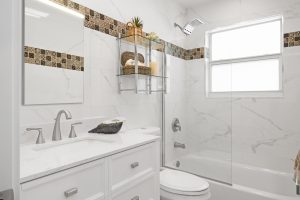
BUDGET-FRIENDLY WHITE TILE WITH HIGHER COST ACCENT TILE IN BATHROOM DESIGN FEATURING THE XAMO COLLECTION
USE LOWER COST MATERIALS OR SHOP SECOND-HAND
When trying to save on costs in your bathroom redesign paint is a great option, but there are some limitations to what you can do with paint itself. So, there are times when you will need to add some material design elements in your bathroom renovation or remodel. To save on costs, you can substitute cheaper materials for pricier ones and get the look you want for less. Or you can stretch your dollars when renovating a bathroom by splurging on just one or two high-impact items such as countertops or a clawfoot tub while choosing less costly alternatives for everything else.
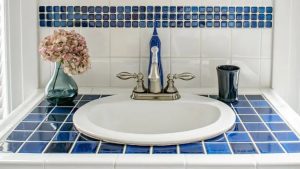
Here are some other cost-effective alternatives for nearly every part of a bathroom remodel:
- Walls – To keep your costs down, limit your use of tile on the walls as much as possible. Use it only in areas that get wet regularly such as, the tub or shower enclosure and add painted drywall on the rest of your walls.
- Flooring – The cheapest options are laminate and vinyl while, wood and ceramic tile are midrange alternatives with stone tile being the costliest.
- Countertops – A stone countertop for your vanity is cheaper than stone counters for your kitchen since it’s a lot smaller counter space. But other options are much less expensive such as, laminate, and ceramic or glass tiles. And engineered stone and solid-surface countertops cost more but are still less costly than granite or marble.
Another way to save on materials for your bathroom renovation is to buy secondhand. Shopping secondhand isn’t as easy as going into a store and putting the items you need in a cart, but with some effort and some luck it’s a huge pay-off in saving you money.
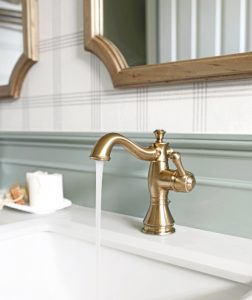
When shopping second-hand, there is a huge advantage to starting early to ensure you have plenty of time to find what you want. So, during the planning phase of your bathroom redesign, start browsing through second-hand sites for items that match your wish list. And with some luck and if you shop in the right places, you can find some great gems such as, a vintage faucet, a salvaged clawfoot tub, discarded cabinet doors from a kitchen and bath showroom or scavenged marble scrap for a countertop.
Places to find secondhand materials include: reuse centres, E-bay, Craigslist, Nextdoor, Facebook Marketplace, Freecycle Network, flea markets, antique stores, yard sales or in your own home where you can repurpose leftover materials from other home design projects.
CONCLUSION
Trying to attain your ‘dream come true’ bathroom design by taking on the expense and task of a bathroom renovation or remodel doesn’t have to cost a small fortune. Even though a bathroom redesign and upgrade can cost thousands of dollars, with good planning and a little creativity you can transform your bathroom into a luxurious retreat on a much smaller budget.
And in the long run this small investment into your bathroom design upgrade will pay for itself when you resell your home because it will boost the value, and therefore boost your earnings on the sale. Keeping an outdated, poorly designed bathroom will have a negative impact on the market value and resale price tag, and appeal of your home.
Here are some other interesting and informative articles on key cost-saving tips to remodel your bathroom space: